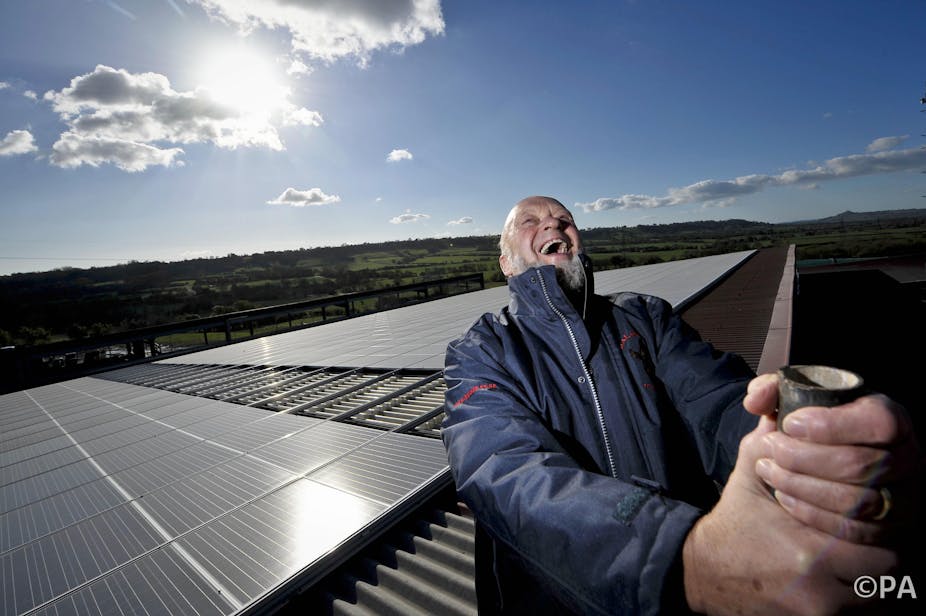One of Britain’s largest independent cheese producers, Wyke Farms in Somerset, picked up a commendation in the BusinessGreen Leaders awards this month for its efforts to become completely energy self-sufficient. By using farm waste to generate heat, power and fertiliser, the farm will cut carbon dioxide emissions by 4,000 tonnes a year.
But they’re not the only one. A survey of UK farmers carried out as part of the Farm As Power Station project revealed that, of 700 respondents, nearly 40% are generating renewable energy on the farm. This shows a substantial jump from Defra’s 2010 study, which found only 5% were.
Of those generating their own energy, half contribute towards national renewable energy targets by selling energy back to the national grid. More than three quarters believe there is further potential for farms to generate renewable energy. It’s possible this attitude of farmers could prove significant, especially since the European Renewable Energy Council reported the UK was unlikely to achieve its target of 20% renewable energy by 2020.
While farmers are willing to invest, there are a number of significant issues that have prevented a broader uptake of the various available technologies.
Farmers clearly need to be confident that government policy will continue to support their investment, so the lack of vision and consistent policy for small scale energy generation has dampened enthusiasm and proven a brake on the development of a local community energy sector.
Investment in farm anaerobic digestion for turning organic waste into fuel has been much slower to develop on farms in the UK than hoped. Only 7% of farmers generating renewable energy used the technology, in stark contrast to other countries in Europe, such as Germany where it has taken off rapidly.
The technology is best suited to create and burn gas made from farm and domestic food waste in small-scale combined heat and power (CHP) plants. However, the investment required has put off many farmers, and the technology is subject to so many regulations that farmers believe they must deliver large, commercial-scale anaerobic digestion plants to make the investment worthwhile. Alternatively a much larger number, 21%, burnt farm waste+ such as straw and manure for heat, rather than to generate electricity.
Wind energy constitutes 30% of renewable energy currently generated from farms. A major barrier to developing wind is the planning system and difficulties engaging the local community - even in cases where they are expected to benefit.
So perhaps it’s not a surprise that the most popular form of renewable energy among farmers is solar power, used by 66% of power generating farmers. Generating energy with solar panels is straightforward, and they can be erected relatively easily and inconspicuously on farm land and buildings.
More than 60% of farmers in the survey plan to invest in renewable technology in the next five years. So how can the government best ensure this investment is made, is not wasted, and brings the most benefit to the communities around the farms?
There are technical challenges for the renewables industry to grapple with, not least of which is the need to match technology to the type of farm in order to get the most power per hectare. For instance anaerobic digestion is expensive to set up with ongoing maintenance costs, which puts farmers off - even though it may be the right technology for a farm rich in vegetable waste or livestock slurry. The temptation to go for a solution that is quick but perhaps less beneficial in the long run needs to be avoided.
There’s more work to be done to help farmers to ensure financial and town planners are up to speed on the opportunities the sector affords. Potential investors may be put off by the need to convince the community during planning decisions, and planning authorities could provide better support for projects that would benefit the local community.
The Farm as Power Station project is a partnership between Nottingham Trent University, Forum for the Future, and Farmers’ Weekly magazine. For the next phase, the project aims to bring major retailers, banks and energy companies together with farmers to tackle the challenges and opportunities of renewable power together. This will develop blueprints that demonstrate the possibilities from using more than one technology on different types of farm, and provide support to farmers willing to take the plunge and invest.
Without more consistent government support, renewable energy from from farms won’t generate enough power to close any power stations in the near future. But used together with advances in smart grids and energy storage it could play a significant role in improving local energy security and resilience to shocks within the UK’s energy supply.

